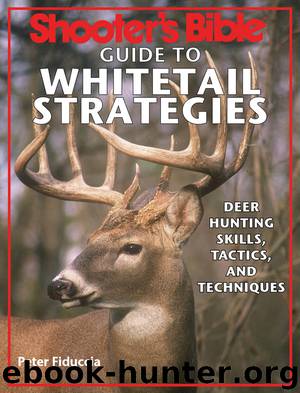Shooter's Bible Guide to Whitetail Strategies by Peter J. Fiduccia

Author:Peter J. Fiduccia
Language: eng
Format: epub
Publisher: Skyhorse
Published: 2016-02-25T16:00:00+00:00
Ralph Somma with a buck shot during a moon cycle when buck activity was supposedly going to be slow. That’s why I hunt, rather than worry about what phase the moon is in.
The gravitational pull of the moon is strong. Its pull affects many life forms and natural wonders in our world–there is no doubt in my mind about that. There is also no denying that the moon’s pull affects the tides in the oceans. But does the moon’s lunar cycle play an important enough role to have hunters plan their entire deer season around the stages of its cycle? This is the question that needs to be answered once and for all.
Many deer stalkers are convinced that significant whitetail activity is greatest during specific moon phases. Many hunters tell me they are certain they see more deer moving during midday after especially dark nights, solely due to the cycle of a new moon.
The assumption is that dark nights make it difficult for deer to move easily within their range, forcing them to move more during daylight hours. Still others are certain the primary rut takes place during the rutting moon (which is close to the second full moon after the autumn equinox).
Many devoted hunters have been convinced by so-called authorities that lunar phases are critical for timing deer movement during specific moon phases, but believe me, there are many facts that suggest that is simply not the case.
Researchers from the University of Georgia’s School of Forest Resources examined how the moon’s lunar phases affect the timing of the white-tailed deer’s breeding behavior. They wanted to find out if deer hunters who strive to bag a buck should concentrate their hunting tactics during a full, new, or partial moon.
David Osborn, Dr. Karl Miller, and Robert Warren, UGA wildlife research biologists, used breeding-date data from a variety of state wildlife agencies to determine if moon phases had any effect on whitetail doe estrous cycles and, therefore, the rutting activities and behavior of bucks. Breeding dates were gathered from captive deer in four states and more than 2,000 free-ranging does in seven others. Believe it or not, this information took between three to nineteen years to compile. It was then compared to lunar cycles throughout the birth date ranges.
“We would expect annual breeding dates for a population to be similar if the calendar date and therefore, the same length of daylight, was the driving influence,” explained Osborn. “We would expect annual breeding to be less similar if moon phase is the driving influence because a particular moon phase might vary as much as 28 days across years.”
The fact is, and many of you have heard me preach this for years, biologists and scientists have long agreed that photoperiod (the length of daylight) is the overriding influence on whitetail breeding activity. There are no bones about it–the evidence is quite clear. Scientists and biologists agree that the phase of the moon has virtually nothing to do with the timing of whitetail breeding activity.
For
Download
Shooter's Bible Guide to Whitetail Strategies by Peter J. Fiduccia.epub
This site does not store any files on its server. We only index and link to content provided by other sites. Please contact the content providers to delete copyright contents if any and email us, we'll remove relevant links or contents immediately.
Sapiens: A Brief History of Humankind by Yuval Noah Harari(14258)
The Tidewater Tales by John Barth(12610)
Mastermind: How to Think Like Sherlock Holmes by Maria Konnikova(7236)
Do No Harm Stories of Life, Death and Brain Surgery by Henry Marsh(6891)
The Thirst by Nesbo Jo(6838)
Why We Sleep: Unlocking the Power of Sleep and Dreams by Matthew Walker(6620)
Life 3.0: Being Human in the Age of Artificial Intelligence by Tegmark Max(5480)
Sapiens by Yuval Noah Harari(5298)
The Longevity Diet by Valter Longo(5021)
The Body: A Guide for Occupants by Bill Bryson(4979)
The Rules Do Not Apply by Ariel Levy(4870)
The Immortal Life of Henrietta Lacks by Rebecca Skloot(4529)
Animal Frequency by Melissa Alvarez(4400)
Why We Sleep by Matthew Walker(4366)
The Hacking of the American Mind by Robert H. Lustig(4319)
Yoga Anatomy by Kaminoff Leslie(4310)
All Creatures Great and Small by James Herriot(4239)
Double Down (Diary of a Wimpy Kid Book 11) by Jeff Kinney(4210)
Embedded Programming with Modern C++ Cookbook by Igor Viarheichyk(4112)
